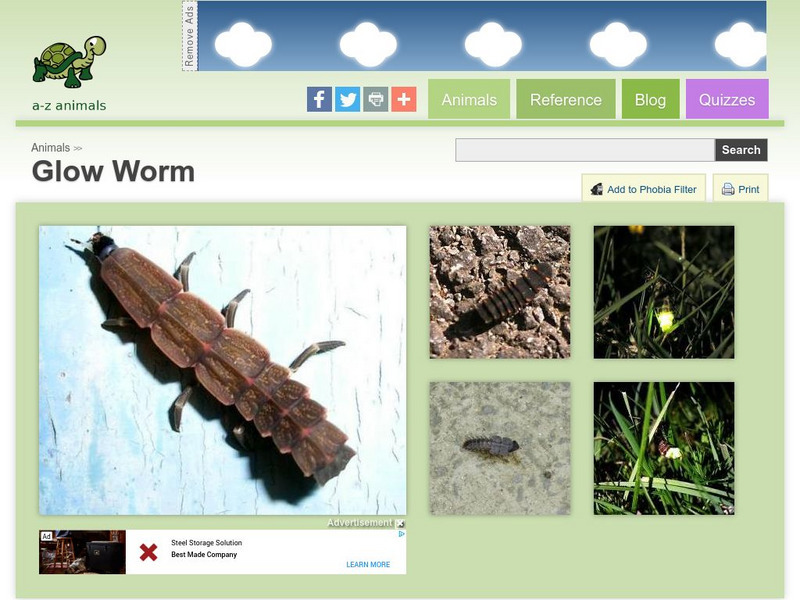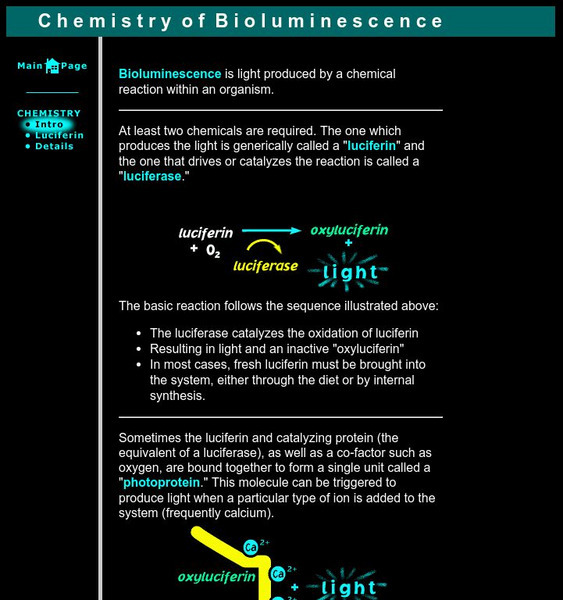Science Education Resource Center at Carleton College
Serc: Who Has the Light?
This lesson explores bioluminescence. Discover which deep-sea organisms are capable of bioluminescence, and how this ability benefits these organisms. In this activity, students compare and contrast chemiluminescence, bioluminescence,...
Science Education Resource Center at Carleton College
Serc: Glow: Living Lights
Accompanying an exhibit called "Glow: Living Lights" is this lesson that explores the chemical compounds and adaptations of bioluminescence and other glowing terrestrial animals.
Science Education Resource Center at Carleton College
Serc: All That Glitters
This Ocean Explorer lesson plan (PDF) explores the questions: What colors, if any, are visible down in the deep sea? What is bioluminescence? Students will learn about white light (visible light), the quantity and quality of light as...
Science Education Resource Center at Carleton College
Serc: Bioluminescence: Living Light
This National Geographic lesson plan explores bioluminescent creatures and the underwater world in which they live. Using shoeboxes and black paint, students are directed to build a deep-sea model and inhabit it with fish made out of...
TED Talks
Ted: Ted Ed: The Weird, Wonderful World of Bioluminescence
In the deep, dark ocean, many sea creatures make their own light for hunting, mating and self-defense. Bioluminescence expert Edith Widder brings some of her glowing friends onstage, and shows more astonishing footage of glowing undersea...
TED Talks
Ted: Ted Ed: Underwater Astonishments
David Gallo shows jaw-dropping footage of amazing sea creatures, including a color-shifting cuttlefish, a perfectly camouflaged octopus, and a Times Square's worth of neon light displays from fish who live in the blackest depths of the...
Woods Hole Oceanographic Institution
Woods Hole Oceanographic Institute: Where Can I Get Answers About Oceanography?
This site provides answers to frequently asked questions about oceanography. Find out more about ocean science by following the link above. What is the difference between oceanography and marine biology?
Davidson College
Physiology of Bioluminescence in Marine Animals
This physiology project page covers bioluminescence, how it works, what organisms are capable of it, and its purpose.
Smithsonian Institution
Smithsonian National Zoo: Zoogoer Magazine: Living Light
Alison Fromme's article in Zoogoer, "Living Light," examines the role of light and luminescence in the lives of animals with specific attention given to those creatures which are able to manifest their own bioluminescence.
A-Z Animals
A Z Animals: Animal Facts: Glow Worm (Arachnocampa Luminosa)
This entry identifies the defining characteristics of Arachnocampa Luminosa, more commonly known as the Glow Worm.
American Museum of Natural History
American Museum of Natural History: Glowing in the Ocean
This site focuses on underwater animals that create their own light using bioluminescence. It also provides the lyrics and audio of a catchy tune putting bioluminescence in the spotlight.
University of California
Uscb: The Bioluminescence Web Page
A very detailed covering of bioluminescence including myths, organisms, chemistry, physiology, and photos. Contains many links for further information.
University of California
University of California at Santa Barbara: Chemistry of Bioluminescence
A very nice animated basic explanation of the difference between fluorescence and bioluminescence.
University of Florida
Florida Museum of Natural History: Fish Adaptations
This site has pictures that illustrate the many ways fish have adapted to make the most of life in their environments. The explanations are short and easy to understand.
Science Struck
Science Struck: Interesting Facts About the Abyssal Zone
The Abyssal Zone lies deep in the ocean in the pelagic layer between 4,000 to 6,000 m or 13,000 to 19,500 ft. Learn about some of the unique life forms that call this zone their home, how they have adapted to the extreme pressure and...
Other
Nicky Case: Fireflies
Fireflies can put on quite a light show! Watch a whole mangrove forest filled with fireflies lighting up and plunging into darkness over and over again in perfect synchrony. How do thousands of fireflies coordinate with each other? The...
PBS
Secretes of the Ocean Realm: Creatures of Darkness
A PBS series site designed for educators to teach students the concempt of bioluminescence in marine life.
PBS
Pbs Teachers: Scientific American: Beneath the Sea: Light Stick Chemistry
Explore chemiluminescence and describe how the temperature of the chemicals that combine in a light stick affects the reaction. Apply that knowledge to understand bioluminescence in deep-sea marine life.
Curated OER
Science Kids: Science Images: Bioluminescence
Bioluminescence from a mesopelagic species that lives under the sea. Its bright light is captured beautifully in this photo.

















